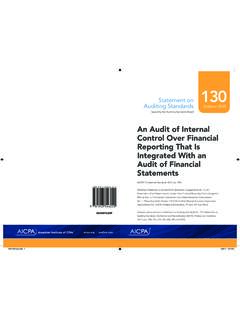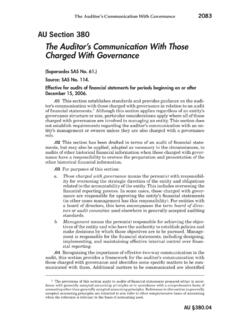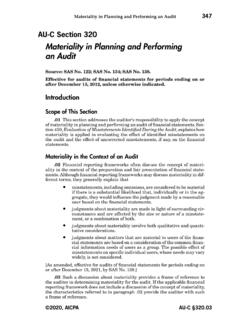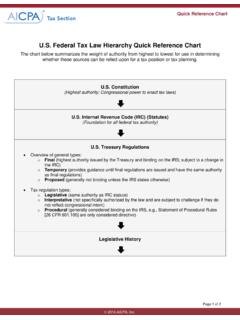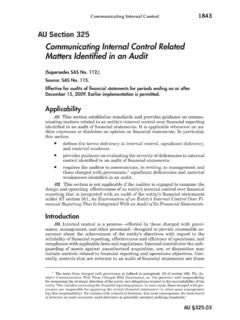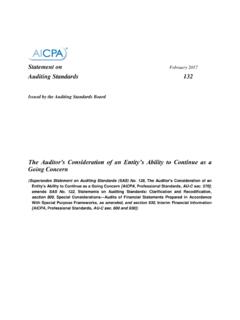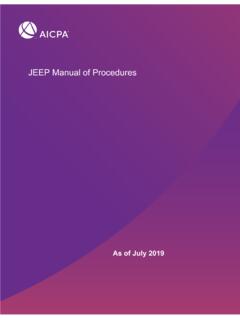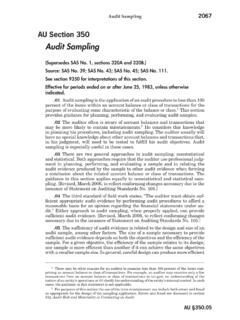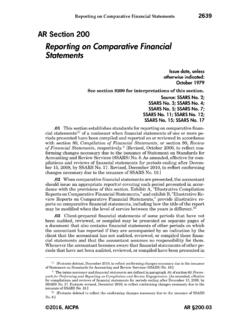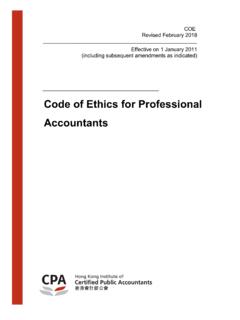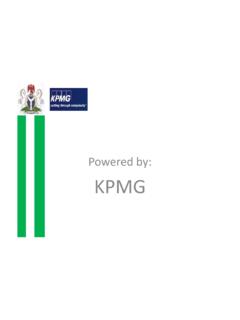Transcription of AICPA Ethics Codification Project
1 AICPA Ethics Codification Project Briefing Paper In December 2008, the AICPA launched the Ethics Codification Project to reformat and enhance its Ethics literature so that members and other users of the AICPA Code of Professional Conduct could apply the rules and reach correct conclusions more easily and intuitively. Similar to the FASB Accounting Standards Codification TM the literature was put into a logically structured, topical format and re-drafted using consistent wording conventions and styles. After four years of planning, drafting and pilot testing, the AICPA plans to expose the revised AICPA s Code of Professional Conduct (the AICPA Code) for comment on April 15, 2013. The following summary provides an overview of the Project in a question and answer format.
2 Why is the AICPA Undertaking this Project ? The AICPA Code and related guidance is in need of transformation. Existing in multiple locations, similar subject matters are sometimes disjointed, making it difficult for members to know whether they have considered all the relevant matters. Further, some Ethics guidance resides outside the AICPA Code (for example, informal AICPA staff positions and basis for conclusions documents, which carry no authority but provide helpful guidance or background on the rules). The Project provided an opportunity to re-evaluate that guidance and determine whether to propose that some of it be made authoritative and incorporated into the revised AICPA Code. What are the Primary Objectives of the Project ?
3 The primary objectives of the Codification Project are to improve the AICPA Code by making it topical and easier to use. Other important goals of Codification will be to retain the substance of the existing AICPA Ethics standards, improve research capability via the use of technology, and enhance the clarity of the AICPA Code through the use of consistent drafting conventions and styles. How does the Codification Project Relate to PEEC s Convergence Efforts? Since 2001, the AICPA Professional Ethics Executive Committee (PEEC) has been converging the AICPA Code with the international Ethics Standards Board for accountants (IESBA) Code of Ethics for Professional accountants (IESBA Code). As a member body of the international federation of accountants (IFAC), the AICPA agrees to have Ethics standards Page 2 that at a minimum meet the IESBA Ethics standards.
4 Therefore, the PEEC considered convergence issues as the revised Code was developed. In this context, convergence means the PEEC may propose changes to AICPA guidance that is less strict than guidance in the IESBA Code or does not exist in the current Code. However, any proposed changes to the revised AICPA Code resulting from these efforts will follow full due process as described in the AICPA Bylaws, which includes exposure of the proposed standard to the membership and consideration of all comments at PEEC meetings that are open to the public. Convergence does not mean that the PEEC will adopt lower standards when international standards are not as strict. Rather, the PEEC will maintain the high ethical standards of the current AICPA Code.
5 One significant element of the IESBA Code, with which the AICPA has begun to converge, is the conceptual framework approach to ethical compliance. What is the conceptual framework approach? The conceptual framework approach (also known as the threats and safeguards approach) provides a system for identifying and evaluating threats to compliance with ethical standards ( , independence) and determining whether safeguards would eliminate threats or reduce them to an acceptable level ( , such that they no longer impair independence). The AICPA Code adopted the Conceptual Framework for AICPA Independence Rules (the Framework) as an authoritative standard in 2006. A brief illustration of the approach, which is similar to that used in the IESBA Code, follows: An audit partner s daughter is a human resources manager with the client.
6 While the partner is performing the audit, his daughter receives an unexpected and very expensive gift from the company s Controller. The concerned partner consults the Code, concluding that independence would be impaired if he received an expensive gift from the client, but the Code is silent in terms of gifts given to his close relatives. Under AICPA rules, he is required to apply the Framework. The partner identifies this situation as an undue influence threat to his independence (ET (c)), particularly to the appearance of his independence. He evaluates the significance of the threat to determine whether the threat is at an acceptable level ( ., would not compromise his professional judgment). If he thought the threat was insignificant, no further action would be required.
7 However, he considers the threat significant, so next he considers whether safeguards controls that counter threats could eliminate or sufficiently reduce the threat to an acceptable level. He believes that the only safeguards that would eliminate the threat to his independence would be to have his daughter return the gift to the controller or for him to no longer serve the client. He must Page 3 apply these safeguards; otherwise his independence would be considered impaired. He also plans to discuss the matter with other appropriate persons in his firm and potentially, the client. As illustrated above, the conceptual framework approach supplements the independence rules by allowing members a mechanism for evaluating matters when specific guidance does not exist in the Code.
8 Currently, members are not required to apply the conceptual framework when they identify threats to their compliance with other rules in the code ( , Rule 102, Integrity and Objectivity). However, they may apply nonauthoritative guidance in the Guide to Complying with Rules 102-505, which is based on the same threats and safeguards approach. How would the Code be impacted? Currently, the AICPA Code requires members to apply the Framework when a member identifies a threat to independence and the rules do not address the specific situation. Further incorporation of the conceptual framework approach into the AICPA Code would not change that the existing rules and their interpretations, which the PEEC has agreed should not change in the Codification process, would continue to apply and the Framework would apply only when no rules exist.
9 (In fact, in many cases, the only safeguards that would eliminate or sufficiently mitigate a threat would be prohibition of the interest or relationship.) Thus, incorporation of this approach would not weaken the AICPA Code or make the application of the Code more subject to judgment than it is today. Through the Codification , several provisions (primarily independence) were recast in terms of threats and safeguards, which is a significant change from today s Code. However, the PEEC believes that discussions of threats and safeguards in specific provisions, where appropriate, would enhance the Code by providing additional context for the rules of conduct and guidance on the application of the Framework. For example, Interpretation 101-1 (ET section ) in the existing AICPA Code states in part that Independence shall be considered to be impaired if during the period of the professional engagement a covered member had or was committed to acquire any direct or material indirect financial interest in the client.
10 Through the Codification process, this section was recast to provide additional context and reads as follows: If a covered member had or was committed to acquire any direct financial interest in an attest client during the period of the professional engagement, the self-interest threat to the covered member s compliance with the Independence rule would not be at an acceptable level and could not be reduced to an acceptable level by the application of safeguards. Accordingly, independence would be impaired. Page 4 If a covered member had or was committed to acquire any material indirect financial interest in an attest client during the period of the professional engagement, the self-interest threat to the covered member s compliance with the Independence rule would not be at an acceptable level and could not be reduced to an acceptable level by the application of safeguards.
